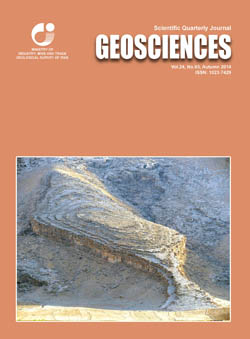Document Type : Original Research Paper
Authors
1 Ph.D. Student, Department of Geology, Islamic Azad University, Science and Research Branch, Tehran; Assistant Professor, Department of Geology, Islamic Azad University, Kermanshah Branch, Kermanshah, Iran
2 Assistant Professor, Department of Geology, Islamic Azad University, Science and Research Branch, Tehran, Iran
3 Associate Professor, Department of Geology, Faculty of Basic Sciences, Tarbiat Modares University, Tehran, Iran
4 Assistant Professor, Research Institute for Earth Sciences, Geological Survey of Iran, Tehran, Iran
5 Associate Professor, Research Institute for Earth Sciences, Geological Survey of Iran, Tehran, Iran
6 M.Sc., Geological Survey of Iran, Tehran, Iran
Abstract
The Gazestan magnetite–apatite deposit is situated 78 km east of Bafq. The Gazestan deposit is located in Bafq-Poshtebadam subzone of Central Iran structural zone. The rock units in the area belong to the Rizu series and consist of carbonate rocks, shale, tuff, sandstone and volcanics. In addition to sedimentary and volcanic rocks, intrusive rocks in the form of stock and dyke outcrop as diorite gabbro, gabbro, diabase, quartz-monzonite and granite in various places. The green rocks with acidic to intermediate composition (trachyte and dacite demonstrate green color due to alteration) host iron and phosphate mineralization which in some localities, show subvolcanic facies. The alteration is more obvious in the volcanic rocks and includes chloritization, argillic, silicification, and also formation of mafic minerals such as epidote, tremolite and actinolite. The host rocks are strongly altered. Mineralization at the Gazestan deposit comprises a combination of iron oxides and apatite with various ratios accompanied by quartz and calcite, observed in different forms mainly within the trachytic-dacitic rocks and a small proportion in the rhyolites. Five forms of mineralization are distinguished in the area including massive iron ore with minor apatite, apatite-magnetite ore, irregular vein-veinlets (stockwork) in the brecciated green rocks, disseminated, and pure massive apatite veins. The host rocks in the Gazestan area plot on calc-alkaline field. Comparison of the most important characteristics of the Gazestan deposit (including tectonic setting, host rock, mineralogy, alteration, structure and texture) with those of various types of mineralization in the world suggest that the deposit is quite similar to the iron oxide - apatite deposits.
Keywords

